Rivera Sun's Blog: From the Desk of Rivera Sun, page 29
March 24, 2016
The Original Treehuggers
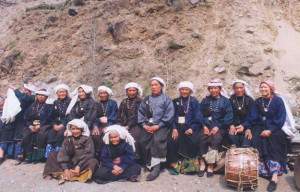
“Surviving Members of the Original Reni Squad at the Chipko 30th Anniversary 2004” By Ceti at English Wikipedia, CC BY-SA 3.0
The next time someone calls you a treehugger, say thank you . . . then proceed to tell them the origins of the treehuggers.
In 1730, in India, local villagers of the Bishnoi sect, led by a woman named Amrita Devi, threw their arms around the trunks of a sacred forest, trying to protect the trees from the soldiers of a king who had sent them to cut wood for the construction of his new palace. Three hundred and sixty three people were killed, and the massacre led to a royal decree forbidding any more tree-cutting in Bishnoi villages. The Bishnoi sect of Hinduism was founded in 1451, by Guru Jambheshwar, who gave the message to protect trees and wildlife, prophesying that harming the environment meant harming one’s self. The tenets of the sect were tailored to conserve bio-diversity of the area and ensure a healthy eco-friendly social life for the community.
In the 1970s, the Bishnois inspired the Chipko Movement, comprised mostly of women, who similarly embraced trees to prevent them from being cut down. The Chipko Movement (which means, “to cling”) faced numerous confrontations with logging companies, and reached a major stand-off on March 25th, 1974, when Gaura Devi and twenty-seven women in the village of Reni held an all-night treehugging vigil to prevent loggers from cutting trees. The action spread to nearby villages, resulting in hundreds of Chipko participants engaged in a four-day stand-off with the loggers. They were successful in preserving the trees.
Over the years, the Chipko Movement set up cooperatives to guard local forests, and also organized fodder production at rates conducive to local environment. Next, they joined in land rotation schemes for fodder collection, helped replant degraded land, and established and ran nurseries stocked with species they selected. They also fought mining projects, dams, and established seed saving endeavors which continue to this day.
So, the next time someone calls you a “treehugger”, raise your head high and reply with dignity. It is quite a compliment!
Learn more about the Chipko Movement here.
This essay was featured in Pace e Bene / Campaign Nonviolence’s daily email, “This Nonviolent Life”, which delivers quotes and stories like this about nonviolence to your inbox each morning. Sign up here. It’s free!
Photo Credit: “Surviving Members of the Original Reni Squad at the Chipko 30th Anniversary 2004” By Ceti at English Wikipedia, CC BY-SA 3.0, https://commons.wikimedia.org/w/index...
____________________
 Author/Activist Rivera Sun, syndicated by PeaceVoice, is the author of The Dandelion Insurrection, Billionaire Buddha and Steam Drills, Treadmills, and Shooting Stars, the cohost of Occupy Radio and Love (and Revolution) Radio, and the cofounder of the Love-In-Action Network. She is a trainer and social media coordinator for Campaign Nonviolence and Pace e Bene. Sun attended the James Lawson Institute on Strategic Nonviolent Resistance in 2014 and her essays on social justice movements appear in Truthout and Popular Resistance. www.riverasun.com
Author/Activist Rivera Sun, syndicated by PeaceVoice, is the author of The Dandelion Insurrection, Billionaire Buddha and Steam Drills, Treadmills, and Shooting Stars, the cohost of Occupy Radio and Love (and Revolution) Radio, and the cofounder of the Love-In-Action Network. She is a trainer and social media coordinator for Campaign Nonviolence and Pace e Bene. Sun attended the James Lawson Institute on Strategic Nonviolent Resistance in 2014 and her essays on social justice movements appear in Truthout and Popular Resistance. www.riverasun.com
March 17, 2016
Celebrating Boycotts on St. Patrick’s Day
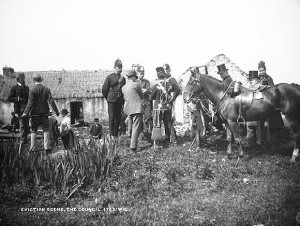
Photo Credit: “Eviction Scene The Council” # 1763 scene the Vandeleur estate, County Clare by Lawrence Collection – National Library of Ireland, Public Domain,
St. Patrick’s Day is nearly here, and while many will be headed to pubs with shamrocks pinned to their jackets to celebrate all things Irish, there is one contribution from Ireland that bears a toast (or two!): the boycott.
Coined in 1880 during the Irish Land Wars, the phrase refers to Captain Charles Boycott, a land agent for Lord Erne. It was a rough year, harvests had been poor, and the tenants had petitioned for a 25 percent rent reduction due to hardship. It had been refused. Boycott attempted to evict 11 tenant farmers. Outraged, the rest of the community began a social ostracism campaign, shunning the captain, refusing to help harvest his crops, and non-cooperating with his eviction efforts.
Irish author George Moore reported: “Like a comet the verb ‘boycott’ appeared.” Within six weeks, newspapers as far away as New York City were using the term.
According to Wikipedia, a “boycott is an act of voluntarily abstaining from using, buying, or dealing with a person, organization, or country as an expression of protest, usually for social or political reasons. The purpose of a boycott is to inflict some economic loss on the target, or to indicate a moral outrage, to try to compel the target to alter an objectionable behavior.”
There is hardly a nonviolent movement around the world, out of hundreds of case studies, that has not used some form of a boycott! Think of Gandhi’s spinning wheel and concurrent boycott of British cloth imports, the American Independence movement’s boycott of tea, the Montgomery Bus Boycott and the United Farm Workers’ Grape Boycott, the boycott of white-owned stores in South African townships during the anti-apartheid struggle: the examples are numerous. So, this St. Patrick’s Day, while you’re celebrating leprechauns, shamrocks and all things Irish, lift a glass and raise a toast to one of Ireland’s greatest contributions to a more just and equitable world: the boycott.
________________________
Author/Activist Rivera Sun, syndicated by PeaceVoice , is the author of The Dandelion Insurrection and other books, and the co-founder of the Love-In-Action Network.
March 8, 2016
Midwife to the Coming World – an excerpt from The Dandelion Insurrection
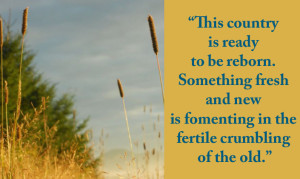 This is an excerpt from Rivera Sun’s novel, The Dandelion Insurrection, featuring a moment when Zadie Byrd Gray commits to being a love-motivated changemaker and living up to her inner potential. Find the whole novel here.
This is an excerpt from Rivera Sun’s novel, The Dandelion Insurrection, featuring a moment when Zadie Byrd Gray commits to being a love-motivated changemaker and living up to her inner potential. Find the whole novel here.
That afternoon, Zadie’s mother had delivered an ultimatum to her girl.
“There is a whole new way of life just waiting to be born,” she had said. “It is standing on the threshold of reality, begging for a mother.”
It hung out there in the night sky as visible as the stars. Ellen had seen it. As soon as her words curled around the notion, the nebulous shape took form.
“This country is ready to be reborn. Something fresh and new is fomenting in the fertile crumbling of the old. Compassion, connection, collaboration, and clean environments churn impatiently in the ethers. Bring them in, Zadie. I know you can.”
Mothers stand on the bedrock certainty of births. Ellen had carried Zadie as a part of her own life’s blood for nine months and delivered her into the world kicking and screaming. Ellen read her daughter like a book; corners turned down and favorite passages underlined with the pencil marks of memory. She knew, beyond a doubt, that Zadie could bring a world of change to this country, powerfully, swiftly, and without hesitation . . . if she chose to do so.
Zadie leaned on the doorframe of Tucker’s back porch watching the moths and mayflies dart in dizzy circles around the lamp. She snapped the switch off, releasing the poor insects from their frantic lust for light. The night’s depth climbed the porch steps and curled up against the curtained windows. As her eyes adjusted, stars emerged across the black expanse. She sat down on the porch steps and let the worn wood press against her, cool and firmly reassuring. Her uncertain heart thudded frantically in her chest. The child of an idea waited breathlessly for her answer.
Show me, Zadie thought, show me what you are.
Truly? the looming concept replied.
Yes, she answered firmly.
All of me?
Yes.
It hesitated. Zadie sensed that whatever hung out there hoping for her acceptance drew back in concern that its truth would not set her free; it would send her running away in terror. Zadie felt a fire rise within her. Women who stood up to become mothers of nations often died in the process. History attested to that. Zadie wanted stark clarity about this creature asking to be born. There could be no holding back. No flirtatious games of hide and seek. No presentations of little cherubs or perfect angels. She demanded to know the mysteries that other mothers can only guess.
Show me who you are! she commanded fiercely.
It gathered like the breath of a tsunami. A flicker of fear touched her gut. Enormity amassed. Without warning, reality cracked open and split the night down the middle. Light so bright it defied the eyes blasted through Zadie’s body. She was blinded and deafened as Love roared from the depths of the universe. This was not the love of pink valentines and pecks on cheeks. This was a blazingly fierce and painful force that raked its talons through the soul and sliced all nonsense into shreds. This Love tore open the body of reality, splitting the pumping heart of blood and aortas and vascular chambers like an obstacle to truth. Death came and went, passed by as inconsequential. Thoughts of religion withered before its blaze. Notions of race and class hid themselves in shame, crying, we are nothing, we are nothing, we are nothing to the greatness of this Love. Zadie screamed in silent agony or ecstasy, there was no telling which. Words formed within the soundless roar of Love.
I was here before the Universe. I will remain when all is gone. I am coming to walk the Earth again . . . inside every human form.
Zadie died. She resurrected. She died again. She returned. Some tiny strand of sanity shuddered. Truth began to tear apart her being. She could not hold on much longer.
The last message shot out from the infinite.
Love is coming back to Earth . . . get ready.
And then it was gone.
Zadie sat shaking on the steps of Tucker’s porch. The black fabric of the night hung still and silent. One woman cannot be the mother of that, she thought in awe. Never in a thousand years. We are not designed to be the vessels for that power. Zadie wrapped her arms around her torso, feeling the frailty of ribs and skin. She breathed deeply, shivering. She could not carry all of that. It would take all of us, Zadie thought; every single person must be the mother of this vision. Suddenly, she froze. Each gleaming star in the sky sharpened into crystalline clarity.
She was not meant to be the mother of this nation . . . she was being asked to be the midwife to its Love.
______________
An excerpt from Rivera Sun’s novel, The Dandelion Insurrection. Find reviews and copies here.
March 4, 2016
10 Things To Know About Nonviolent Struggle
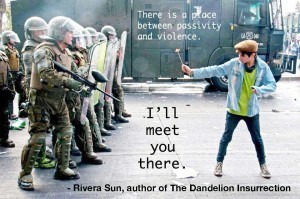
“There is a place between passivity and violence. I’ll meet you there.” – Rivera Sun
Nonviolent struggle is on the rise globally. Neither passive, nor inaction, this powerful way of working for change is proving Gandhi’s audacious claim that “nonviolence is the greatest force at the disposal of mankind” to be correct. Here are ten things you should know about nonviolent struggle and how it works.
1. Nonviolent action is used around the world by people of all classes, races, genders, sexualities, faiths, and political beliefs to accomplish a wide range of goals including changing governmental regimes, ending occupations, expelling foreign invasions, overthrowing dictators, stopping destructive industries, protecting the environment, gaining civil rights, creating economic justice and much more.
2. Nonviolent action is twice as successful as violent means, works in a third of the amount of time, and incurs a fraction of the casualties as violent conflict.
3. While researchers don’t know how few people are necessary to successfully use nonviolent action to accomplish their goals, researchers do know that every movement they studied that successfully mobilized 3.5% of the populace always won.
4. There are over two hundred methods of nonviolent action, including marches, demonstrations, rallies, boycotts, strikes, sit-ins, blockades, noncooperation, civil disobedience, work stoppages and slowdowns, refusal to provide services and much more.
5. There are two hands of nonviolence: the hand that says no to injustice, and the hand that says yes to justice. Gandhian nonviolence might refer to these as obstructive and constructive programs. Others refer to the two-fold strategy as “oppose and propose”, or noncooperation with the destructive and cooperation with the beneficial. For example, a movement might work to ban factory farming while simultaneously encouraging the support of local, small farms.
6. Use acts of protest and persuasion such as speeches, fliers, and marches to spread knowledge of your issue or cause. Use constructive actions such as alternative institutions and parallel governments to build new systems rooted in justice. And, use acts of noncooperation and intervention such as boycotts, strikes, shut-downs, etc. to disrupt the injustice and remove cooperation and consent.
7. Movements use a series of nonviolent actions to build a campaign around a specific objective. A series of campaigns builds into a set of stepping-stones to accomplish the large goals of the movement.
8. Nonviolent movements for change seek to remove support from the injustice, and instead place support in systems of justice. These types of support may include material resources, money, human resources, skills and knowledge, authority, the sanction-power of police and military, communications, public opinion, and intangible factors such as obedience, fear, hope, loyalty, etc.
9. Unlike violent conflicts which dehumanize people in order to hurt or kill them, nonviolent movements benefit from humanizing everyone involved, including the movement, the opposition, and the bystanders.
10. Nonviolent struggle is used by ordinary, extraordinary people just like you and me. Find a movement, get involved, start a campaign, participate in an action, build an alternative system, and find ways to make change right where you are.
______________________
 Rivera Sun is the author of The Dandelion Insurrection, Billionaire Buddha, and Steam Drills, Treadmills, and Shooting Stars, and the cohost of Love (and Revolution) Radio. Rivera speaks, educates, and offers workshops on nonviolent struggle. Her essays on social justice movements appear in Truthout and Popular Resistance. www.riverasun.com
Rivera Sun is the author of The Dandelion Insurrection, Billionaire Buddha, and Steam Drills, Treadmills, and Shooting Stars, and the cohost of Love (and Revolution) Radio. Rivera speaks, educates, and offers workshops on nonviolent struggle. Her essays on social justice movements appear in Truthout and Popular Resistance. www.riverasun.com
February 6, 2016
The Frontier Gandhi: Khan Abdul Ghaffar Khan
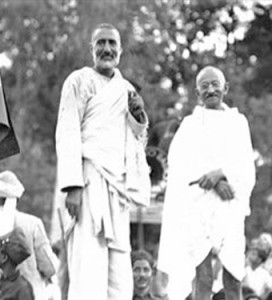
“Badshah Khan” (pictured with Gandhi) by Unknown – http://www.peaceworkmagazine.org/pwor.... Licensed under Public Domain via Commons
Khan Abdul Ghaffar Khan was born on Feb 6th, 1890 in the Peshawar Valley of British-controlled India. At the age of twenty, Ghaffar Khan founded a village mosque school, and began his revolutionary work against British colonial control with what his contemporary Mohandas K. Gandhi was calling “constructive programme”. He worked tirelessly for independence and self-rule, forming a close relationship with Gandhi.
Ghaffar Khan formed the Khudai Khidmatgar, “Servants of God”, which grew to include 80,000-100,000 people. Some consider this to be the first nonviolent army . . . and the Servants of God remain one of the largest examples in history of a sustained, ongoing, nonviolent organization. The Servants of God faced the brutal and violent repression of the British with indomitable will. One time, Ghaffar Khan asked Gandhi why his Pashtuns were staying committed to nonviolence despite the repression at a time when many Hindus were losing their nerve and falling back on violence. The Mahatma said, “We Hindus have always been nonviolent, but we haven’t always been brave.” Gandhi’s point was similar to Dr. Martin Luther King, Jr.’s, that “nonviolence is a way of life for courageous people”, and that the Pashtuns, for all of their complex and often violent history, had cultivated the bravery and courage necessary for waging nonviolence.
Ghaffar Khan was called by several nicknames and honorifics, including “Badshah” or “Bacha” which means “King of Chiefs”, and “The Frontier Gandhi”. He was arrested, beaten, exiled and held under house arrest for much of his life. He died at age 97 in Afghanistan, where he is buried. Despite the heavy fighting at the time, both sides of the Soviet war in Afghanistan, the communist army and the mujahedeen, declared a ceasefire to allow his burial. Two hundred thousand people joined his funeral procession to honor his life’s work. As Michael Nagler points out in an article on Badshah Khan, the remarkable efforts of the Frontier Gandhi should be known to us all as a jaw-dropping example of a Muslim peacemaker devoted to nonviolence.
Read more on Wikipedia: https://en.wikipedia.org/wiki/Khan_Abdul_Ghaffar_Khan
Read Michael Nagler’s essay on Badshah Khan, including the six myths of nonviolence busted by Khan’s work:
http://wagingnonviolence.org/2013/07/who-was-badshah-khan/
Read this excellent article by Tim Flinders: http://www.calpeacepower.org/0101/muslim_ghandi.htm
For a deeper read, try Eknath Easwaran’s biography of Badshah Khan, Nonviolent Soldier of Islam: Badshah Khan: A Man to Match His Mountains:
http://www.amazon.com/Nonviolent-Soldier-Islam-Badshah-Mountains/dp/1888314001
This profile was written by Rivera Sun for Pace e Bene/Campaign Nonviolence’s email series, “This Nonviolent Life”, which features daily quotes and once-a-week profiles on nonviolent struggles. Sign up for this free service here.
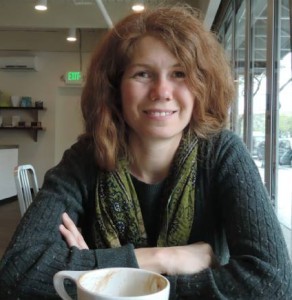 Author/Activist Rivera Sun, syndicated by PeaceVoice, is the author of The Dandelion Insurrection, Billionaire Buddha and Steam Drills, Treadmills, and Shooting Stars, the cohost of Occupy Radio and Love (and Revolution) Radio, and the cofounder of the Love-In-Action Network. She is a trainer and social media coordinator for Campaign Nonviolence and Pace e Bene. Sun attended the James Lawson Institute on Strategic Nonviolent Resistance in 2014 and her essays on social justice movements appear in Truthout and Popular Resistance. www.riverasun.com
Author/Activist Rivera Sun, syndicated by PeaceVoice, is the author of The Dandelion Insurrection, Billionaire Buddha and Steam Drills, Treadmills, and Shooting Stars, the cohost of Occupy Radio and Love (and Revolution) Radio, and the cofounder of the Love-In-Action Network. She is a trainer and social media coordinator for Campaign Nonviolence and Pace e Bene. Sun attended the James Lawson Institute on Strategic Nonviolent Resistance in 2014 and her essays on social justice movements appear in Truthout and Popular Resistance. www.riverasun.com
February 4, 2016
Know Your Nonviolent History: Leymah Gbowee
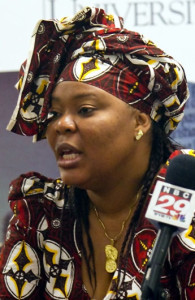
Leymah Gbowee (October 2011)” autorstwa Leymah-gbowee-at-emu-press-conference.jpg: Jon Styer/Eastern Mennonite Universityderivative work: César – Ten plik jest pochodną pracą Leymah-gbowee-at-emu-press-conference.jpg:. Licencja CC BY 3.0 na podstawie Wikimedia Commons –
“We are tired of war. We are tired of running. We are tired of begging for bulgur wheat. We are tired of our children being raped. We are now taking this stand, to secure the future of our children. Because we believe, as custodians of society, tomorrow our children will ask us, “Mama, what was your role during the crisis?”” -Leymah Gbowee, in a speech to President Charles Taylor and Grace Minor, president of the Senate of Liberia.
Born on Feb 1st, 1972, Leymah Gbowee is a Liberian peace activist. She was seventeen years old when the first Liberian Civil War erupted, throwing the region into violence and chaos. In spring of 2002, after falling asleep in her office one night, she awoke from a dream where she says God had told her, “Gather the women and pray for peace!”
By the summer of 2002, Gbowee was recognized as the spokeswoman and inspirational leader of the Women of Liberia Mass Action for Peace, described as a peace movement that started with local women praying and singing in a fish market. Gathering women across religious and ethnic lines, Gbowee led thousands of Christians and Muslims into actions in Monrovia for months. They prayed for peace, using Muslim and Christian prayers, and eventually held daily nonviolent demonstrations and sit-ins in defiance of orders from President Charles Taylor.
They staged protests that included the threat of a curse and a sex strike. “The [sex] strike lasted, on and off, for a few months,” Gbowee said. “It had little or no practical effect, but it was extremely valuable in getting us media attention.”
In a highly risky move, the women occupied a soccer field along the route President Charles Taylor traveled twice a day, to and from Capitol Hill. Demonstrating, occupying, and wearing white clothes and headbands as a symbol of peace, the women were eventually successful in securing an audience with Taylor. Leymah Gbowee was designated spokeswoman, and gave a speech which included the quote at the start of this essay.
In June 2003, Gbowee led a delegation of Liberian women to Ghana to put pressure on the warring factions during the peace-talk process. When the talks dragged into late July, with no progress made and violence continuing in Liberia, Gbowee passed a message to the lead mediator, General Abubakar (a former president of Nigeria), that hundreds of women would interlock their arms and remain seated in the hallway until a peace agreement was reached. Abubakar announced with some amusement: “The peace hall has been seized by General Leymah and her troops.” When the men tried to leave the hall, Leymah and her allies threatened to rip their clothes off – in Africa, it was considered a terrible curse to see a married or elderly woman deliberately bare herself. With Abubakar’s support, the women remained sitting outside the negotiating room during the following days, ensuring that the “atmosphere at the peace talks changed from circuslike to somber.”
The Liberian war ended officially weeks later August 18, 2003. In addition to bringing an end to 14 years of warfare in Liberia, this women’s movement led to the election of Leymah Gbowee’s cohort, Ellen Johnson Sirleaf, as president of Liberia in 2005, the first elected woman leader of a country in Africa. Sirleaf is co-recipient of the 2011 Nobel Peace Prize along with Gbowee and Tawakel Karman.
The Women of Liberia Mass Action for Peace is powerfully depicted in the documentary film, Pray the Devil Back to Hell.
Learn more about Leymah Gwobee here:
https://en.wikipedia.org/wiki/Leymah_Gbowee
Find great video clips of her speeches on her website, here:
http://leymahgbowee.com/
This profile was written by Rivera Sun for Pace e Bene/Campaign Nonviolence’s email series, “This Nonviolent Life”, which features daily quotes and once-a-week profiles on nonviolent struggles. Sign up for this free service here.
January 14, 2016
Friday Night Films: Iron Jawed Angels
 If you have a passel of teenage girls headed to your house for a slumber party, perhaps go out on a limb as being the weird parent, and screen Iron Jawed Angels as an act of resistance to violence as usual in the coming of age stories of young women. After all, we’ve been subjected to Catniss in the Hunger Games, Beatrice in Divergent, and Lisbeth in The Girl Who Kicked the Hornets’ Nest. If we don’t want our young girls growing up somewhere between anemic princesses and deadly assassins, perhaps we ought to show them the third option between fight and flight: nonviolent action for equality and justice.
If you have a passel of teenage girls headed to your house for a slumber party, perhaps go out on a limb as being the weird parent, and screen Iron Jawed Angels as an act of resistance to violence as usual in the coming of age stories of young women. After all, we’ve been subjected to Catniss in the Hunger Games, Beatrice in Divergent, and Lisbeth in The Girl Who Kicked the Hornets’ Nest. If we don’t want our young girls growing up somewhere between anemic princesses and deadly assassins, perhaps we ought to show them the third option between fight and flight: nonviolent action for equality and justice.
Iron Jawed Angels is engaging and fairly historically accurate, aside from the fictionalized love interest. The film focuses on the American women’s suffrage movement during the 1910s, and follows women’s suffrage leaders Alice Paul and Lucy Burns as they use peaceful and effective nonviolent strategies, tactics, and dialogues to revolutionize the American feminist movement to grant women the right to vote. Hilary Swank plays Alice Paul, Juila Ormond portrays Inez Milholland, and Anjelica Houston takes on the inimitable Carrie Chapman Catt.
The film title comes from Massachusetts Representative Joseph Walsh, who in 1917 opposed the creation of a committee to deal with women’s suffrage. Walsh thought the creation of a committee would be yielding to “the nagging of iron-jawed angels” and referred to the Silent Sentinels as “bewildered, deluded creatures with short skirts and short hair.” (Wikipedia, https://en.wikipedia.org/wiki/Iron_Ja...)
Try it out on your teenagers . . . it might change their life.
Trailer to Embed:
January 8, 2016
Bread and Roses Strike begins Jan 11 & 12, 1912
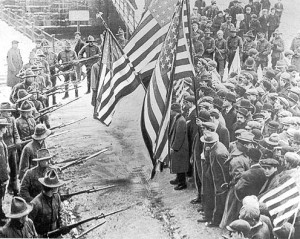
“1912 Lawrence Textile Strike 1”. Licensed under Public Domain via Commons
This week is the 104th anniversary of the Lowell Textile Strike that later became known as the Bread and Roses strike. On Jan 11th and 12th, 1912 women working in the textile factories of Lowell, Massachusetts walked out en masse and started a two month strike that would later become known as the Bread and Roses strike, after a line in a speech given by Rose Schneiderman “The worker must have bread, but she needs roses, too.” The phrase would be adapted into a poem by James Oppenheim, which included the lines:
As we come marching, marching in the beauty of the day,
A million darkened kitchens, a thousand mill lofts gray,
Are touched with all the radiance that a sudden sun discloses,
For the people hear us singing: “Bread and roses! Bread and roses!”
As we come marching, marching, we battle too for men,
For they are women’s children, and we mother them again.
Our lives shall not be sweated from birth until life closes;
Hearts starve as well as bodies; give us bread, but give us roses!
As we come marching, marching, unnumbered women dead
Go crying through our singing their ancient cry for bread.
Small art and love and beauty their drudging spirits knew.
Yes, it is bread we fight for—but we fight for roses, too!
As we come marching, marching, we bring the greater days.
The rising of the women means the rising of the race.
No more the drudge and idler—ten that toil where one reposes,
But a sharing of life’s glories: Bread and roses! Bread and roses!
The striking workers, mostly women, sent their children to stay with supporters in New York, which helped them maintain the strike and raise awareness of their efforts. On March 14th, 1912, the strike concluded successfully with terms favorable to the workers.
Know your nonviolent history . . . it might change your life.
Learn more about the strike:
https://en.wikipedia.org/wiki/1912_Lawrence_textile_strike
Listen to Joan Baez sing “Bread and Roses”
Bread and Roses was featured on Love (and Revolution) Radio in our “Know Your Nonviolent History” segment. Sign up for the podcast here.
 Author/Activist Rivera Sun, syndicated by PeaceVoice, is the author of The Dandelion Insurrection, Billionaire Buddha and Steam Drills, Treadmills, and Shooting Stars, the cohost of Occupy Radio and Love (and Revolution) Radio, and the cofounder of the Love-In-Action Network. She is a trainer and social media coordinator for Campaign Nonviolence and Pace e Bene. Sun attended the James Lawson Institute on Strategic Nonviolent Resistance in 2014 and her essays on social justice movements appear in Truthout and Popular Resistance. www.riverasun.com
Author/Activist Rivera Sun, syndicated by PeaceVoice, is the author of The Dandelion Insurrection, Billionaire Buddha and Steam Drills, Treadmills, and Shooting Stars, the cohost of Occupy Radio and Love (and Revolution) Radio, and the cofounder of the Love-In-Action Network. She is a trainer and social media coordinator for Campaign Nonviolence and Pace e Bene. Sun attended the James Lawson Institute on Strategic Nonviolent Resistance in 2014 and her essays on social justice movements appear in Truthout and Popular Resistance. www.riverasun.com
Alice Paul and US Women’s Suffrage
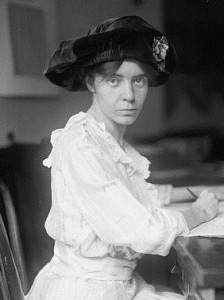
“Alice Paul1915” by Harris & Ewing – This image is available from the United States Library of Congress’s Prints and Photographs division under the digital ID hec.06766. Licensed under Public Domain via Wikimedia Commons
“Alice Paul had “a spirit like Joan of Arc, and it is useless to try to change it. She will die but she will never give up.” – Physician at Occoquan Workhouse where Alice Paul was imprisoned for nonviolent actions to win women’s suffrage in the United States.
Alice Paul was born on Jan 11th, 1885. It was a good year for activists . . . A.J. Muste entered the world just a few days earlier that same year. She cut her activist teeth with the British Suffrage movement, working with Christabel and Emmeline Pankhurst in 1909. One time, before a political meeting at St. Andrew’s Hall in Glasgow in August 1909, Paul camped out on the roof of the hall so that she could address the crowd below. She was cheered by the crowd as police forced her to come down. At other times she was imprisoned, beaten, ridiculed, organized hunger strikes in prison and force-fed by prison physicians to break the protests . . . all of which was eerily prescient of the conditions Alice Paul and the American Suffragettes would face later in the US.
Alice would differ from her British counterparts in allowing no property destruction or violent tactics to be deployed in the course of the US movement. She organized provocative, powerful marches and demonstrations, stomped the country working on building up support in the states, and adopted a challenging tactical strategy of demonstration known as the Silent Sentinels which protested six days a week in front of the White House for two and a half years.
After the Nineteenth Amendment was passed and ratified by the states, Alice Paul continued her work organizing for the Equal Rights Amendment (which has yet to be passed) and securing a provision in the 1964 Civil Rights Act for the protection of women.
A few unusual facts: Alice Paul earned a law degree in 1922, followed by a Doctorate in Civil Laws in 1927. She is also featured on the $10 gold coin, which is part of a series of Presidential wives, in lieu of Pres. Chester Arthur’s wife, since he entered the White House as a widower.
Learn more: The Alice Paul Institute has a terrific bio and resources: http://www.alicepaul.org/
Still curious? George Lakey, a longtime activist, wrote an insightful piece on tactics and strategies of the US and British Women’s Suffrage Movements, including interviews with suffragettes, and also a review of the film Suffragette. Read it on Waging Nonviolence.
 Author/Activist Rivera Sun, syndicated by PeaceVoice, is the author of The Dandelion Insurrection, Billionaire Buddha and Steam Drills, Treadmills, and Shooting Stars, the cohost of Occupy Radio and Love (and Revolution) Radio, and the cofounder of the Love-In-Action Network. She is a trainer and social media coordinator for Campaign Nonviolence and Pace e Bene. Sun attended the James Lawson Institute on Strategic Nonviolent Resistance in 2014 and her essays on social justice movements appear in Truthout and Popular Resistance. www.riverasun.com
Author/Activist Rivera Sun, syndicated by PeaceVoice, is the author of The Dandelion Insurrection, Billionaire Buddha and Steam Drills, Treadmills, and Shooting Stars, the cohost of Occupy Radio and Love (and Revolution) Radio, and the cofounder of the Love-In-Action Network. She is a trainer and social media coordinator for Campaign Nonviolence and Pace e Bene. Sun attended the James Lawson Institute on Strategic Nonviolent Resistance in 2014 and her essays on social justice movements appear in Truthout and Popular Resistance. www.riverasun.com
January 7, 2016
Silent Sentinels Start Suffrage Protest on Jan 10th, 1917
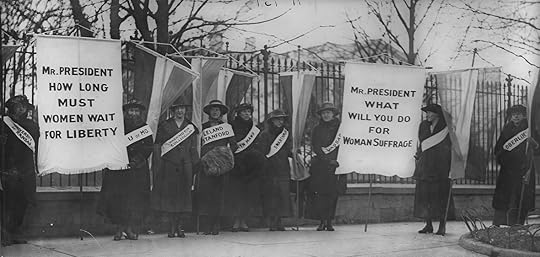
“Women suffragists picketing in front of the White house”. Licensed under Public Domain via Commons.
On this day in nonviolent history, the Silent Sentinels began their two and a half years long protest in front of the White House demanding Women’s Suffrage. They were organized by Alice Paul, Lucy Burns, and the National Woman’s Party. The women began on Jan 10th, 1917 and protested for six days a week until June 4, 1919 when the Nineteenth Amendment to the United States Constitution was passed both by the House of Representatives and the Senate. (Wikipedia, https://en.wikipedia.org/wiki/Silent_Sentinels )
The name Silent Sentinels was given to the women because of their silent protesting. Using silence as a form of protest was a new principled, strategic, and rhetorical strategy within the national suffrage movement and within their own assortment of protest strategies.
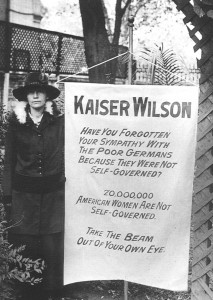
“Suffragette banner carried in picket of the White House” by Harris & Ewing, Washington, D.C. (Photographer) – http://hdl.loc.gov/loc.mss/mnwp.160030. Licensed under Public Domain via Commons
The two-and-a-half year long protest sparked outrage, fury, beatings, scorn, derision, and arrests. The horrific conditions of the Occoquan Workhouse (torture, beatings, rotten food, lice, vermin, and force feeding the suffragettes raw eggs to break their hunger strike protest) ignited public sentiment and brought the cause further to national attention.
After Congress passed the Nineteenth Amendment on June 4th, the suffragettes turned their attention to state ratification. Tennessee turned out to be the tipping point state on Aug 18th, 1920, becoming the thirty-sixth state to ratify the Nineteenth Amendment. It was won by the single vote of a legislator (Harry T. Burn) who had opposed the amendment but changed his position after his mother sent him a telegram saying “Dear Son, Hurrah! and vote for suffrage. Don’t forget to be a good boy and help Mrs. Catt put the ‘rat’ in ratification.”
What was on their signs? Remember as you read this that Woodrow Wilson was in the White House and World War I was ramping up!
“Mr. President, what will you do for woman suffrage?”
“Mr. President, how long must women wait for liberty?”
“We shall fight for the things which we have always carried nearest our hearts–for democracy, for the right of those who submit to authority to have a voice in their own governments.” (Wilson quote as the US entered WWI)
“Kaiser Wilson, have you forgotten your sympathy with the poor Germans because they were not self-governed? 20,000,000 American women are not self-governed. Take the beam out of your own eye.” (comparing Wilson to Kaiser Wilhelm II of Germany, and to a famous quote of Jesus regarding hypocrisy)
Learn more! https://en.wikipedia.org/wiki/Silent_Sentinels
 Author/Activist Rivera Sun, syndicated by PeaceVoice, is the author of The Dandelion Insurrection, Billionaire Buddha and Steam Drills, Treadmills, and Shooting Stars, the cohost of Occupy Radio and Love (and Revolution) Radio, and the cofounder of the Love-In-Action Network. She is a trainer and social media coordinator for Campaign Nonviolence and Pace e Bene. Sun attended the James Lawson Institute on Strategic Nonviolent Resistance in 2014 and her essays on social justice movements appear in Truthout and Popular Resistance. www.riverasun.com
Author/Activist Rivera Sun, syndicated by PeaceVoice, is the author of The Dandelion Insurrection, Billionaire Buddha and Steam Drills, Treadmills, and Shooting Stars, the cohost of Occupy Radio and Love (and Revolution) Radio, and the cofounder of the Love-In-Action Network. She is a trainer and social media coordinator for Campaign Nonviolence and Pace e Bene. Sun attended the James Lawson Institute on Strategic Nonviolent Resistance in 2014 and her essays on social justice movements appear in Truthout and Popular Resistance. www.riverasun.com
From the Desk of Rivera Sun
- Rivera Sun's profile
- 161 followers



